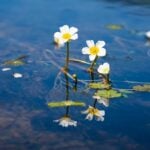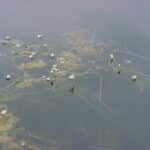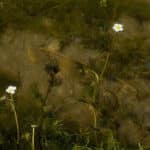Water Buttercup
Other Common Names: white water crowfoot, yellow water buttercup
(Ranunculus longirostris)
Native
Water Buttercup has showy white or yellow flowers during the summer months and has finely divided leaves.
Description
Trailing runners and buried rhizomes are the source of long, branched stems. Water buttercup can form dense mats in quiet waters. Wave action in larger lakes prevents these large colonies because the waves break the brittle stems.
Water buttercup leaves are attached directly or have a very short leaf stalk. When lifted out of the water, leaves are stiff enough to hold their shape. They are arranged alternately along the stems. Leaves are finely divided and can be thread like or flattened.
Five petal flowers can be white or yellow and rise above the water’s surface. Once fruit begins to develop, flower stalks curve back into the water and 15 to 25 nutlets are produced in a cluster.
Ducks and other waterfowl feast on the fruit and foliage of water buttercup. Even grouse or other birds sometimes eat this plant.
Management Options
Click here for more information on how to control water buttercup.
Location
Water Buttercup can be found across the United States.
Propagation
seeds, stem fragments
Management Options
Click here for more information on how to control water buttercup.









